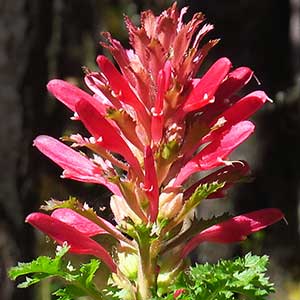Pedicularis densiflora
Pedicularis semibarbata
Indian warrior, warrior's plume
pine woods lousewort, pinewoods pedicularis
basal 1–10, blade lanceolate, 30–200 x 20–70 mm, 2(or 3)-pinnatifid, margins of adjacent lobes nonoverlapping or extensively overlapping distally, 1-serrate, surfaces glabrous, hispid, or downy;
cauline 4–20, blade lanceolate, 15–250 x 5–100 mm, 2-pinnatifid, margins of adjacent lobes nonoverlapping or extensively overlapping distally, serrate, surfaces glabrous, hispid, or downy.
basal 3–5, blade lanceolate or spatulate, 20–90 x 5–30 mm, undivided or 1- or 2-pinnatifid, margins of adjacent lobes nonoverlapping or slightly overlapping distally, entire or dentate, surfaces glabrous or tomentose;
cauline 1 or 2, blade lanceolate, 25–80 x 5–10 mm, 1- or 2-pinnatifid, margins of adjacent lobes nonoverlapping or slightly overlapping distally, serrate to dentate, surfaces glabrous or tomentose.
simple, 1–5, exceeding basal leaves, each 10–50-flowered;
bracts lanceolate to trullate, 10–35 x 3–5 mm, undivided or 1-pinnatifid, proximal margins entire, distal 1- or 2-serrate, surfaces glabrous.
simple, 1–5, not exceeding basal leaves, each 4–20-flowered;
bracts lanceolate to oblanceolate, 30–90 x 5–40 mm, 1- or 2-pinnatifid nearly to midrib, margins serrate to dentate, surfaces glabrous.
2–4 mm.
2–4 mm.
calyx 9–18 mm, downy to tomentose, lobes 5, triangular, 3–4 mm, apex entire, ciliate;
corolla 23–43 mm, tube dark red, purple, or orange-yellow, rarely white, 8–18 mm;
galea dark red, purple, or orange-yellow, rarely white, 15–25 mm, beakless, margins entire medially and distally, apex straight;
abaxial lip dark red, purple, or orange-yellow, rarely white, 8–15 mm.
calyx 7–9 mm, glabrous or tomentose along veins, lobes 5, narrowly triangular, 1.5–5 mm, apex entire, glabrous or ciliate;
corolla 12–25 mm, tube light green or pale yellow, sometimes cream, 7–13 mm;
galea concolored, light green or pale yellow, sometimes cream, 5–12 mm, beakless, margins entire medially and distally, apex nearly straight to arching slightly over abaxial lip;
abaxial lip yellow, sometimes cream, 4–7 mm.
= 16.
= 16.
Pedicularis densiflora
Pedicularis semibarbata
Scarlet corollas with an undomed, toothless galea and two- or three-pinnatifid leaves are diagnostic of Pedicularis densiflora. This species occurs in forested subalpine regions of southern Oregon, western slopes of the Sierra Nevada, and the Coast Ranges of California south to Baja California. Herbarium records indicate northern populations of P. densiflora occur at higher elevations than do more southern populations.
(Discussion copyrighted by Flora of North America; reprinted with permission.)
Subspecies 2 (2 in the flora).
The basal and cauline leaves of Pedicularis semibarbata are distinctly one- or two-pinnatifid into deep pinnae and narrow subpinnae with serrate margins. The leaves and bracts far exceed the length of the inflorescence, often concealing it. Obvious spatulate, tan-colored, undivided, and membranous leaves are proximal to the divided basal leaves, but they are not as conspicuous as those of P. centranthera, a species with a similar growth form. Proximal floral bracts of P. semibarbata are similar to basal and cauline leaves, whereas in some specimens the distal bracts are spatulate and either once-divided or merely serrate at the apex. Surfaces of the corolla tube and sometimes the galea as well are hispid.
Pedicularis semibarbata grows under ponderosa pine, incense cedar, sugar pine, and white fir, primarily in the southern Cascade Range and Sierra Nevada, in the San Bernardino and San Gabriel mountains of California, and the Mount Charleston region of Nevada.
The flowers of Pedicularis semibarbata in Yosemite National Park were pollinated only by Osmia tristella (L. W. Macior 1977).
(Discussion copyrighted by Flora of North America; reprinted with permission.)
1. Corollas 12–20(–22) mm; leaf lobes 6–20 x 3–14 mm; outside of Mount Charleston region, Nevada. | subsp. semibarbata |
1. Corollas 20–25 mm; leaf lobes 3–12 x 1–8 mm; within Mount Charleston region, Nevada. | subsp. charlestonensis |


